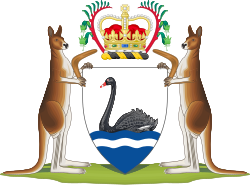Top Qs
Timeline
Chat
Perspective
Parliament of Western Australia
Legislative body of the Australian state of Western Australia From Wikipedia, the free encyclopedia
Remove ads
The Parliament of Western Australia is the bicameral legislature of the Australian state of Western Australia, which constitutes the legislative branch of the state's political system. The parliament consists of the King (represented by the governor), the Legislative Council (the upper house) and the Legislative Assembly (the lower house).[1] The two houses of parliament sit in Parliament House in the state capital, Perth.
For a bill to become law, it must be passed by both the Legislative Council and the Legislative Assembly, and receive royal assent from the Governor.
The party or coalition commanding the support of a majority of the members of the Legislative Assembly is invited by the governor to form government. The head of government holds the office of Premier of Western Australia.[2]
Currently, the Legislative Council has 36 members elected for four-year terms from multi-member constituencies by proportional representation, and the Legislative Assembly has 59 members, elected for four-year terms from single-member constituencies, using preferential voting. As with all other Australian states and territories, enrolment to vote and voting for both Houses is compulsory for all resident Australian citizens—and eligible British citizens (i.e., those permanently resident and on the electoral roll prior to the passage of the Australia Act)—who are over the legal voting age of 18.
Remove ads
History
The Western Australian Legislative Council was created in 1832 as an appointed body. In 1870 the then colony was ruled by a governor and an advisory Legislative Council made up of appointed officials and elected members. The Western Australian Legislative Assembly was created in 1890 when the then colony attained self-government. The first premier was John Forrest, who held office until 1901.
On 3 November 2011, the government introduced fixed four-year terms for Parliament, with elections being held every four years on the second Saturday in March.[3][4] The 2013 state election was the first election under the fixed date system.
Remove ads
Acts of Parliament

The oldest recorded act of Parliament in Western Australia is the Civil Court of Western Australia (1832) act, an act for establishing a Court of Civil Judicature, assented to on 10 February 1832, under the first Governor of Western Australia, James Stirling. It predates the Parliament of Western Australia and was passed by the Western Australian Legislative Council instead.[5] All up, ten acts were passed in 1832.[6]
Since 1832, acts have been passed in every year but 1890, the year the Western Australian Parliament was formed.[5] The last act to be passed prior to the establishment of the Parliament was the Electoral Act 1889,[7] assented to on 26 June 1890.[8]
In 2023, the Western Australian Parliament passed 34 acts.[9]
Remove ads
Longest-serving members
Summarize
Perspective
Members of the Western Australian upper and lower houses with over 30 years of service.
Remove ads
See also
Notes
- After the 2025 election, the Nationals and Liberals formed an opposition alliance. However, it is not a formal coalition and both parties maintain their independence from each other.
- After the 2021 election, the Nationals and Liberals formed an opposition alliance. However, it is not a formal coalition and both parties maintain their independence from each other.
References
External links
Wikiwand - on
Seamless Wikipedia browsing. On steroids.
Remove ads





